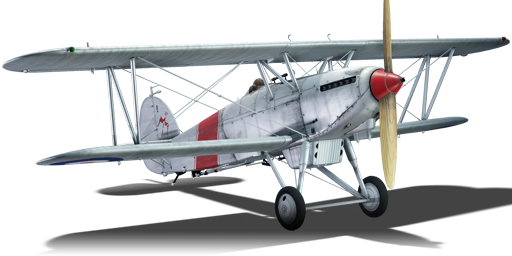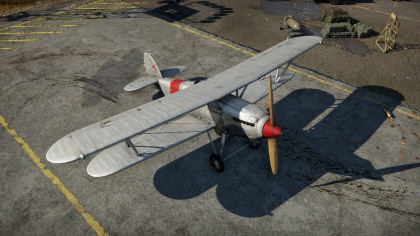Nimrod Mk II
Contents
| This page is about the British naval fighter Nimrod Mk II. For other version, see Nimrod Mk I. |
Description
The Nimrod Mk II is a rank I British naval fighter
with a battle rating of 1.0 (AB/RB/SB). It has been in the game since the start of the Open Beta Test prior to Update 1.27.
The Nimrod Mk.II is a rank I plane for Britain. It is a biplane with 2 x 7.7 mm Vickers machine guns. The main difference between it and the Mk. I is the slightly swept wing and more powerful engine. It is statistically on par with most other Reserve planes of all countries and eras. Climb rate, turn rate, roll rate, and acrobatic ability are superb, mostly due to the Nimrod being a biplane.
The Nimrod is basically a point-and-shoot aircraft in arcade battle. It is intended mainly for beginners with little to no experience in War Thunder. Being a biplane, the Nimrod is very forgiving and thus is very flexible in techniques and tactics. Turn rate provides players with a thrilling beginning in Arcade, and the roll rate and climb rate provides for some interesting acrobatics with the Nimrod. Armament, naturally, is very weak. The 2 x 7.7 mm Vickers are only effective when used to snipe pilots. Against bombers the Vickers MGs are useless.
Although RB puts things into a bigger perspective, the Nimrod plays very similarly to Arcade. Point and shoot and turning are most common with biplanes such as the Nimrod. Endurance is very good given the high ammunition count, and turn, roll, and climb rates are very good. RB with the Nimrod is a great first taste of actual RB play with more specialised planes.
SB with the Nimrod provides a great chance to have the first taste of Simulator Battles. The open cockpit provides beginners with a thrilling experience in the skies, and of course, mechanics are identical to RB. Especially the gun sight provides unique gameplay for beginners.
Overall, the Nimrod provides a pleasurable beginning experience for players who have recently begun the game.
General info
Flight performance
Describe how the aircraft behaves in the air. Speed, manoeuvrability, acceleration and allowable loads - these are the most important characteristics of the vehicle.
| Characteristics | |||||||
|---|---|---|---|---|---|---|---|
| Stock | |||||||
| Max Speed (km/h at 4,100 m) |
Max altitude (meters) |
Turn time (seconds) |
Rate of climb (meters/second) |
Take-off run (meters) | |||
| AB | RB | AB | RB | AB | RB | ||
| 377 | 354 | 8100 | 16.6 | 18.3 | 7.6 | 7.6 | 232 |
| Upgraded | |||||||
| Max Speed (km/h at 4,100 m) |
Max altitude (meters) |
Turn time (seconds) |
Rate of climb (meters/second) |
Take-off run (meters) | |||
| AB | RB | AB | RB | AB | RB | ||
| 412 | 394 | 8100 | 15.8 | 16.0 | 29.5 | 15.7 | 232 |
Details
| Features | ||||
|---|---|---|---|---|
| Combat flaps | Take-off flaps | Landing flaps | Air brakes | Arrestor gear |
| X | X | X | X | ✓ |
| Limits | ||||
|---|---|---|---|---|
| Wing-break speed (km/h) |
Gear limit (km/h) |
Combat flaps (km/h) |
Max Static G | |
| + | - | |||
| 600 | 600 | 520 | ~11 | ~5 |
| Optimal velocities | |||
|---|---|---|---|
| Ailerons (km/h) |
Rudder (km/h) |
Elevators (km/h) |
Radiator (km/h) |
| < 260 | < 280 | < 300 | > 200 |
| Compressor (RB/SB) | ||
|---|---|---|
| Setting 1 | ||
| Optimal altitude | 100% Engine power | WEP Engine power |
| 4,267 m | 600 hp | 768 hp |
Survivability and armour
This aircraft is vulnerable, as there is no armor protection for any of the modules. All the modules are focused towards the front of the plane.
- No Armor Protection
- Self-Sealing Fuel Tanks
Armaments
Offensive armament
The Nimrod Mk II is armed with:
- 2 x 7.7 mm Vickers E machine guns, nose-mounted (600 rpg = 1,200 total)
Usage in battles
Describe the tactics of playing in an aircraft, the features of using aircraft in a team and advice on tactics. Refrain from creating a "guide" - do not impose a single point of view, but instead, give the reader food for thought. Examine the most dangerous enemies and give recommendations on fighting them. If necessary, note the specifics of the game in different modes (AB, RB, SB).
Manual Engine Control
| MEC elements | ||||||
|---|---|---|---|---|---|---|
| Mixer | Pitch | Radiator | Supercharger | Turbocharger | ||
| Oil | Water | Type | ||||
| Controllable | Not controllable Not auto controlled |
Not controllable Not auto controlled |
Controllable Not auto controlled |
Combined | Not controllable 1 gear |
Not controllable |
Modules
| Tier | Flight performance | Survivability | Weaponry | |
|---|---|---|---|---|
| I | Fuselage repair | Radiator | Offensive 7 mm | |
| II | Compressor | Airframe | New 7 mm MGs | |
| III | Wings repair | Engine | ||
| IV | Engine injection | Cover | ||
Pros and cons
Pros:
- Fantastic turn rate
- Good climb rate
- Great roll rate
- Good endurance
Cons:
- Low speed
- Low service ceiling
- Extremely weak armament
- Weak durability
History
Describe the history of the creation and combat usage of the aircraft in more detail than in the introduction. If the historical reference turns out to be too long, take it to a separate article, taking a link to the article about the vehicle and adding a block "/ History" (example: https://wiki.warthunder.com/(Vehicle-name)/History) and add a link to it here using the main template. Be sure to reference text and sources by using <ref></ref>, as well as adding them at the end of the article with <references />. This section may also include the vehicle's dev blog entry (if applicable) and the in-game encyclopedia description (under === In-game description ===, also if applicable).
In-game description
The Hawker Nimrod was a carrier-borne, biplane fighter which entered service with Britain’s Fleet Air Arm in 1931. By 1934, full-scale production of Nimrod Mk.I fighters was replaced by that of Mk.II fighters. All Nimrod Mk.IIs were fitted with an arrestor hook for carrier operations, their wings were modified with a slight sweep back and tail surfaces were slightly larger than those of the Nimrod Mk.I. The powerplant was also improved in the Mk.II; a 608 hp Rolls-Royce Kestrel V liquid cooled, in-line engine replaced the earlier 590 hp engine. Only 30 Nimrod Mk.IIs were build for service in the Fleet Air Arm, although many of the Mk.Is were updated to Mk.II standard.
Hawker Aircraft Ltd failed to receive significant export orders for the Nimrod; only four machines were sent abroad, including one supplied to Japan, one to Portugal, and two to Denmark. The Danish fighters were known as the Nimrodderne.
In 1933, the Fleet Air Arm's units were reorganized. Independent flights were combined into Squadrons, which were numbered from 800 up. Hawker Nimrod fighters were in service with No. 800 (HMS Courageous), 801 (HMS Furious) and 802 (HMS Glorious) Squadrons, with two flights of nine Nimrods in each. The command structure again saw change following the 1937 Inskip Report, when naval aviation was handed back from the Royal Air Force to the Royal Navy, and Britain’s Nimrods became the property of the Admiralty.
The Hawker Nimrod fighter was replaced in first-line units by the Gloster Sea Gladiator and the Blackburn Skua before the start of World War II. Nimrods continued to be operated as training and liaison aircraft until July 1941, by which time they had long been considered obsolete and were taken out of service. The Danish Nimroddernes were used until the German invasion in April 1940, but did not see combat against the Luftwaffe.
Media
Excellent additions to the article would be video guides, screenshots from the game, and photos.
See also
Links to the articles on the War Thunder Wiki that you think will be useful for the reader, for example:
- reference to the series of the aircraft;
- links to approximate analogues of other nations and research trees.
External links
Paste links to sources and external resources, such as:
- topic on the official game forum;
- encyclopedia page on the aircraft;
- other literature.
| Hawker Aircraft Limited | |
|---|---|
| Biplane fighters | |
| Fury | Fury Mk I · Fury Mk II |
| Nimrod | Nimrod Mk I · Nimrod Mk II |
| Scout plane | Osprey Mk IV |
| Piston fighters | |
| Hurricane | Hurricane Mk I/L · Hurricane Mk.I/L FAA M · Sea Hurricane Mk IB · Sea Hurricane Mk IC · Hurricane Mk IIB/Trop · Hurricane Mk IV |
| Typhoon | Typhoon Mk Ia · Typhoon Mk Ib · Typhoon Mk Ib/L |
| Tempest | Tempest Mk V · Tempest Mk V (Vickers P) · Tempest Mk II |
| Fury | Sea Fury FB 11 |
| Jet fighters | |
| Hunter | Hunter F.1 · Hunter F.6 · Hunter FGA.9 |
| Sea Hawk | Sea Hawk FGA.6 |
| Harrier | Harrier GR.1 · Harrier GR.3 |
| Export | ▄Hurricane Mk I/L · ▂Hurricane Mk IIB · ▄Sea Fury FB 51 |
| ▄Sea Hawk Mk.50 · ◄Sea Hawk Mk.100 · ◘Hunter F.6 · ◌Hunter F.58 · J34 · AV-8A · AV-8C | |
| Captured | ▀Tempest Mk V |
| See Also | Fokker |





